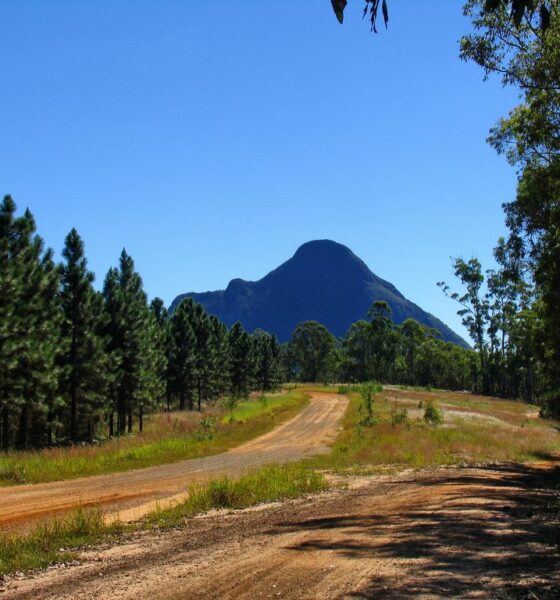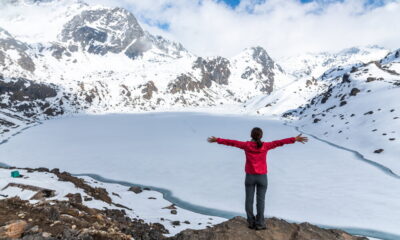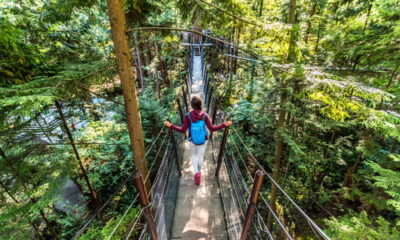

Environment
Sustainable tourism: ‘going green’ doesn’t just mean a splash of colour
Green has become cool. Show me a hotel, restaurant or travel company that doesn’t have a green policy or environmental statement and I will eat my organic hat.
This is, of course, fantastic: the more places that commit to recycling or saving water, the better for us and our environment. Problems appear when ‘going green’ becomes just another marketing ploy; a reason to add 25% to the cost or attract a new audience. In these cases, it is little more than daubing the signage in grassy hues.
Glass House Ecolodge in Australia is therefore something of an anomaly. Situated in the hinterland of the Sunshine Coast, 70km north of Brisbane and surrounded by the 16 dotted peaks of the Glass House Mountains, it is a beautifully designed, stunningly sited, environmentally friendly place to stay.
The park is in the shadow of Mount Tibrogargan, the 364-metre-high monolith that is not only higher than Ayers Rock, but also 23m years older. The past and present, natural and manmade, are all welcomed and fused together to make this the resort that it is.
Back in 1982, owner Keith Murray purchased the land that has been, in previous history, used for pineapple farming, as a soldier settler park and a stop for dedicated cyclists. His vision was that someday, it could become a retreat for weary travellers.
That objective has certainly been achieved, but it is a constantly evolving, living project, all centred on the principle of ecological tourism. Murray’s mantra is also the steering principle for the global organisation the International Eco Club and defined as such:
– Minimises its own environmental impact
– Funds environmental education
– Funds projects that promote equality and reduce poverty in the local community
– Increases environmental and cultural knowledge and intercultural understanding.
It’s a tall order, reconciling all facets – nature, people, local culture and education. As the Ecolodge owner and managers, Robyn and Rick, say, this is the “ideal type of tourism”. The trouble with ideals is that they are very rarely realised.
Add to all the positive and worthy principles outlined above the fact that people want aesthetically pleasing, comfortable and relaxing surroundings when travelling, and it’s no wonder that so many in the hospitality industry settle for the label rather than the lifestyle.
The site is stunning, each curve of the path and glance around revealing something to cause a smile. The largest and most luxurious bedtime option is a 120-year-old wooden church, painstakingly rescued from its original home of Wivenhoe Pocket, a few kilometres down the road, and moved on the back of a truck to be rebuilt on site.
 There are lovingly restored train carriages available, one being the dining area and kitchen where breakfast featuring locally produced honey, coffee and japonica jam can be munched upon.
There are lovingly restored train carriages available, one being the dining area and kitchen where breakfast featuring locally produced honey, coffee and japonica jam can be munched upon.
I stayed in an 1880 Victorian train carriage, one of only 23 built between 1882 and 1886, that was once at risk of destruction and is now a quirky haven for holidaymakers, with original signage and sash windows. Even the bedside tables are made from timber sourced from the property.
Not just an isolated enterprise, they are keen to connect with local businesses and community, and again this is from start to finish. They used 26 local contractors and suppliers of goods during the construction phase of the Ecolodge, ensuring 92% of expenditure remained in the locality, and continue to assist with this by selling locally-grown honey, coffee, macadamia nuts and condiments – as well as local Aboriginal art, boomerangs and didgeridoos.
All around the grounds is art assembled from pieces from the local Beerwah scrapyard, forcing visitors to reconsider what waste really is. It is called ‘flestering’. I think of it as grown-ups looking at scraps like a child looks at a toilet roll – with imagination and desire to create.
There are no televisions. There is a library, board games, bush walking, bird walking and stargazing. Documents guiding residents through the different plants, 60 fruit and vegetables, trees and 80 bird species (to date) are not only available, but fascinating. Soft sounds of the breeze rustling in the trees are layered with birds tweeting. Other than that, there is silence.
The Ecolodge aims to minimise any negative environmental impacts in its business activities, not just occasionally, but on a daily basis. This involves solar hot water, water saving devices, low-energy lighting and waste recyling.
Movement sensitive lights are not only almost magical in their response to you, but they save energy. All rooms are provided with means to separate waste from recycling, and so green trees and vegetable matter is all composted for later use in gardens. In the office, both sides of the paper are used.
I often think that we have labelled certain behaviour as ‘green’ when it is actually just living sensibly, like our grandparents used to. The location means that the gardens are a thriving and abundant feast, all available for guests to pick and use.
I have some tuna and noodles from the city, and without a car, am resigned to a simple meal. Then I wander the community vegetable and herb garden and tropical orchard from which guests can help themselves when preparing a meal, picking fresh lemongrass, chilli, bay leaves and basil. Hello, beautiful and satisfying stir fry, washed down with a glass of local wine, paid for via an honesty box, and finished with a mango from a neighbouring farm (also an honesty box initiative).
It is not only what is within their own grounds that matters, but all around. They are active members, in conjunction with adjacent property owners and the nearby national park, in developing a wildlife corridor. This has resulted in the increase in numbers of reptiles and birds spotted on and near the Ecolodge property.
They have become part of a network of property owners who are actively planting the vines necessary for the ongoing survival of the Richmond Birdwing butterfly that is at risk of extinction.
Although encouraging and supporting people to get out and about and walk the region, and producing guides and tours to the bush, its beasts and its birds, they will withhold information from guests if they believe it to be potentially harmful – for example during koala breeding season.
All of these measures are barely noticeable and did not affect my luxurious lazy feeling at all – yet they are valuable to the environment. They add to, rather than detract from the ambience and experience.
This is the point. Sometimes it seems that it would be best for the environment if everyone just stayed at home, only foraged from the land, and didn’t use anything. But this is not only impractical; it is limiting.
Murray believes that everyone should have access to the natural environmental wonders of the world, in this case the beautiful Glass House Mountains. He also says that visitors can in fact improve things.
As well as relaxing and scenic, holidays offer the opportunity to see and experience something outside of our usual environment. Education and learning are an important byproduct of this, and as a tool for ensuring ecological development, education is crucial.
The national park’s mantra of “leave only footprints – take only photos” is respected, but the Ecolodge believes this is a “very neutral approach” and that visitors will always have some kind of impact upon the ecosystem of any location. Therefore, the impact may as well be positive, enhancing the area.
Its plant-a-tree initiative has seen over 1,000 trees planted by guests, enhancing the biodiversity of the area and attracting species – as has the conversion of an overgrown creek system into a wildlife corridor. In Murray’s words, “We say to guests, ‘Your choice of holiday does make a difference’.”
This places the responsibility back with the consumer. It is up to them to holiday somewhere beautiful, well-managed, relaxing, escapist and comfortable. It’s more than just a marketing tool; it’s a way of life, a partnership between the hosts, both people and physical location, and customers.
In an environment where green has become cool and prices equally so, it’s refreshing to see a place that doesn’t just splash the colour, but actually demonstrates the claims. Connecting conservation, communities and consumers in a way that enhances experiences and the surrounding environment can only have positive results.
Francesca Baker is curious about life and enjoys writing about it. A freelance journalist, event organiser, and minor marketing whizz, she has plenty of ideas, and likes to share them. She writes about music, literature, life, travel, art, London, and other general musings, and organises events that contain at least one of the above. You can find out more at www.andsoshethinks.co.uk.
Further reading:
Thriving, livable and green, Melbourne walks the talk as a sustainable city
Life changing travel and travel changing lives
When on a responsible holiday, do as the locals do
































